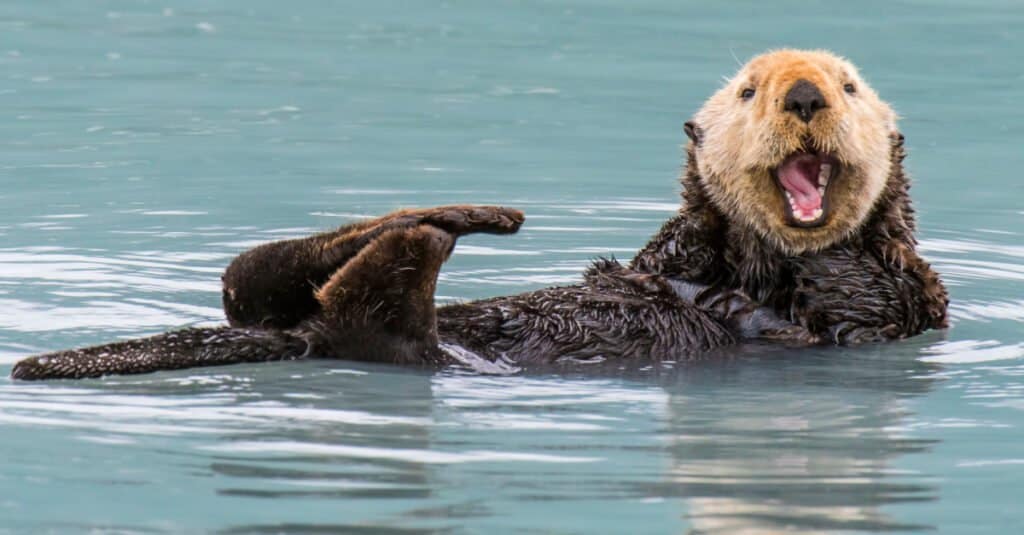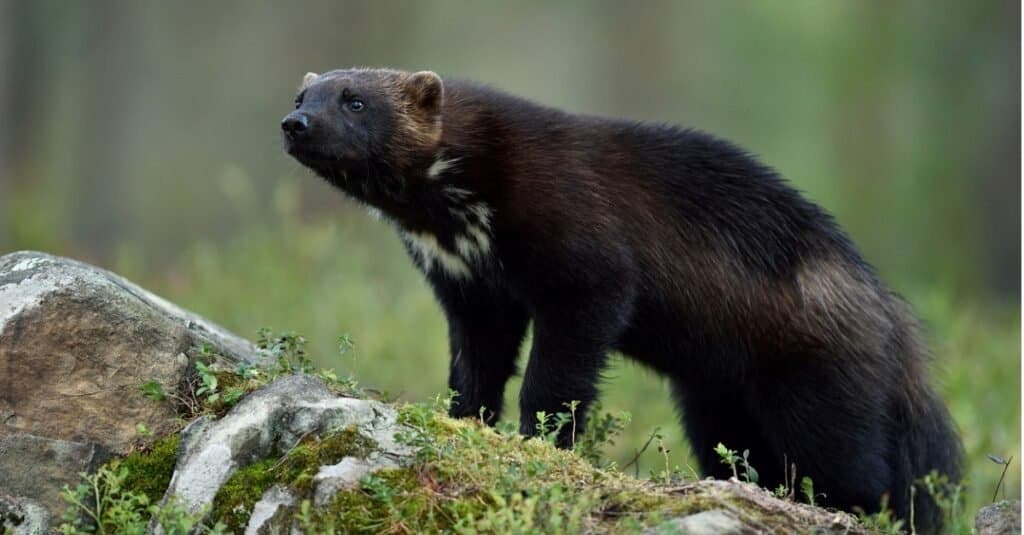Giant otters are a rare and fascinating otter species native to South America. They are one of 13 extant otter species worldwide. These massive otters are important to the health of their environment. According to the Wildlife Conservation Society Peru, giant otters play a key role in balancing freshwater ecosystems by feeding on fish. Let’s find out just how giant these otters are, in both physical size and ecological importance. This article explores giant river otter size, including how it compares to other otters and the average human. Additionally, we cover endangered species status and conservation efforts in South America.

Giant otters are one of the largest animals in the mustelid family (Mustelidae).
©Johnny Giese/Shutterstock.com
Species of Otters and Their Sizes
Otters are in the mustelid family (Mustelidae), which also includes weasels, martens, badgers, mink, and wolverines. There are 13 extant species of otters that are spread across every continent except Australia and Antarctica. Otter species vary in size from around 2 feet long to nearly 6 feet long. Here is a list of the 13 extant otter species:
- Giant otter (Pteronura brasiliensis)
- Sea otter (Enhydra lutris)
- North American river otter (Lontra canadensis)
- Southern river otter (Lontra provocax)
- Neotropical otter (Lontra longicaudis)
- Marine otter (Lontra felina)
- Eurasian otter (Lutra lutra)
- Hairy-nosed otter (Lutra sumatrana)
- Spotted-necked otter (Hydrictis maculicollis)
- Smooth-coated otter (Lutrogale perspicillata)
- African clawless otter (Aonyx capensis)
- Asian small-clawed otter (Aonyx cinereus)
- Congo clawless otter (Aonyx congicus)
Let’s explore the largest and smallest otter species, including giant otter size!
Largest Otter Species by Length
The giant otter is the longest species of otter. According to a 2015 study of giant otters in Peru, adult males range from 4 feet 11 inches to 5 feet 11 inches and weigh 50-70 pounds. The same study states that sexual dimorphism, a term for physical differences between sexes of the same species, is minor in giant otters. As a result, female giant otters are only slightly smaller than males. Adult female giant otters range from 4 feet 11 inches to 5 feet 7 inches and weigh 44-64 pounds.
Largest Otter Species by Weight
Sea otters are not only the heaviest species of otter, but they are also the heaviest species in the mustelid family. They can weigh up to a whopping 100 pounds! However, their weight varies by sex and subspecies. Males are heavier than females, and northern sea otters (Enhydra lutris kenyoni) are heavier than southern sea otters (Enhydra lutris nereis). Female northern sea otters weigh up to 70 pounds, while males weigh up to 100 pounds. For southern sea otters, the smaller of the two North American subspecies, females weigh up to 50 pounds and males weigh up to 70 pounds. As for length, females range from 3 feet 3 inches to 4 feet 7 inches while males range from 3 feet 11 inches to 4 feet 11 inches. Sea otters are listed as Endangered by the IUCN, and oil spills are the largest threat to their population.
Smallest Otter Species
The smallest otter species is the Asian small-clawed otter, measuring around 2 feet long and weighing less than 10 pounds. Asian small-clawed otters are listed as Vulnerable by the IUCN due to habitat loss and pollution.
Are Giant Otters Bigger Than Sea Otters?

Sea otters are the heaviest mustelid, but not the longest.
©iStock.com/David McGowen
Which species is bigger, the giant otter or the sea otter? The answer depends on the subspecies of sea otter and whether we compare weight or length. When comparing weight, sea otters are generally heavier than giant otters. Adult male northern sea otters weigh up to 100 pounds, while adult male giant otters only weigh up to 70 pounds. However, giant otters can be as heavy as southern sea otters, the smallest subspecies, which weigh up to 70 pounds.
As for length, giant otters are much longer than sea otters. Adult male giant otters measure as long as 5 feet 11 inches, while adult male sea otters only measure to 4 feet 11 inches. That’s one whole foot difference in length between giant otters and sea otters!
Are Giant Otters Bigger Than Wolverines?

Wolverines are similar in size to medium dog breeds such as the
Australian shepherd
.
©iStock.com/ErikMandre
How do giant otters compare to wolverines, the largest terrestrial (non-aquatic) mustelid? Wolverines range from 2 feet 2 inches to 3 feet 8 inches in length. Adult males weigh 24-40 pounds while females weigh 18-26 pounds. Although wolverines are the largest terrestrial mustelid, they are no match for the size of the giant otter. Measuring up to 5 feet 11 inches and 70 pounds, adult male giant otters can be over 2 feet longer than wolverines and over 30 pounds heavier.
Giant Otter vs. Human Size Comparison
Let’s see how a giant otter’s size compares to the average human in the United States. According to the Centers for Disease Control and Prevention (CDC), the average American man is 5 feet 9 inches while the average American woman is 5 feet 3.5 inches. That means that a giant otter at 5 feet 11 inches long is two inches longer than the average American man and 5.5 inches longer than the average American woman. When we compare by weight, however, humans are much heavier. According to the same CDC study, American men weigh 200 pounds on average while American women weigh 170 pounds on average. Since giant otters only weigh up to 70 pounds, the average American man is nearly three times as heavy while the average American woman is around two and a half times as heavy. American children, however, are closer in weight to giant otters. According to the CDC, the average American eight-year-old is around 70 pounds, which is the exact maximum weight of a giant otter.
How Big Are Giant Otters When They Are Born?
Baby otters are called cubs. According to a 2015 study from Brazil, the average newborn giant otter cub born in the wild weighs 316.25 grams, which converts to 11.16 ounces. That’s about as heavy as two baseballs or a can of soda. This study notes that the average weight of a giant otter cub in the wild is heavier than those in captivity.
Conclusion
In this article, we explored how big giant otters are and how their size compares to other animals. Giant otters are not only the longest species of otter, but they are also the longest animal in the entire mustelid family (Mustelidae). Growing up to 5 feet 11 inches, giant otters are longer than both sea otters and wolverines. In terms of weight, however, the sea otter beats the giant otter. Sea otters are the heaviest mustelids, weighing up to 100 pounds.
Giant otters are also longer than a lot of humans. The average woman in the United States is 5 feet 3.5 inches, which is 7.5 inches shorter than the maximum length of a giant otter. It is safe to say that giant otters are longer than most American women. They are also two inches taller than the average American man, who is 5 feet 11 inches tall.
In addition to being physically large, giant otters also have a massive impact on their environments. They are crucial to maintaining the health of freshwater wetlands in South America. Governments, indigenous communities, and conservation organizations are all working to protect and restore giant otter habitat. In fact, Peru designated one million acres of Manu National Park as a protected area for giant otters as part of the Giant Otter Project. The Isla de los Valles indigenous community also designated over 8000 acres of their land as a protected area for the otters. While the population of giant otters is decreasing according to the IUCN, serious efforts are being made by dedicated people to ensure their habitat is protected for years to come.
The photo featured at the top of this post is © ThiagoSantos/Shutterstock.com
Thank you for reading! Have some feedback for us? Contact the AZ Animals editorial team.






